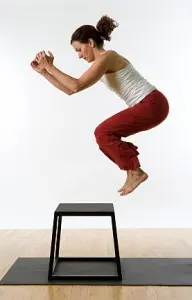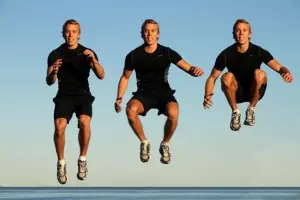Plyometrics
Plyometric training is a large aspect of the Sportsmetrics program; however, many people don’t exactly know what it really is. Plyometrics, also known as Plyos, are high velocity exercises that involve fast movements causing the muscles to stretch and contract quickly like jumping or bounding. They are designed to help develop your power and speed when done correctly.
How often should I do Plyometrics?
This style of training can be very taxing on the body and is not meant to be done every day. If done correctly, most individuals will be sore the following day or two depending on the intensity of the exercises. The body will need a day of rest to allow the muscles to build after working so hard. Not to mention, when the body gets tired, exercises will get sloppy and not provide the same amount of benefits. Plyometrics is not just a routine that you pick up and start doing on day one. I would recommend if you haven’t worked out in a long time to start with some simple cardio or lifting routines before jumping into plyometric training. Once you have started incorporating it into your routine, plyometrics should only be done at the maximum 2-3 times a week.

When completing plyometric training, it is recommended an individual do a small number of sets/repetitions or simply jump for a certain length of time. For example, with easier jumps, like wall jumps where the athlete stands against the wall and quickly hops with two feet, we will tell the individual to get as many “good” jumps, not sacrificing technique, as possible. After several sessions of 20 seconds we will then build to 25 or 30 seconds. With harder jumps, like box jumps, we will start with 5 “good” jumps and progress up to as many as 10. Though this part of the workout may seem quick, if done with the correct technique, it will be more beneficial than doing high sets or reps of lesser quality skill.
So what is beneficial v. ineffective technique?
Now that I have been discussing beneficial technique, what do I really mean? With a wide array of jumps we go over like tuck jumps, squat jumps, scissor jumps, broad jumps, side to side hopping or bounding there are a specific group of common skills we want to teach athletes.
First, always start a jump in an athletic stance, with the knees shoulder width apart and slightly bent. This puts the body and your muscles in the best possible posture for maximum effort in the jump. Next, complete the jump with full effort. Finally, the landing is key and where athletes can gain the most technique.

The athlete’s feet need to land shoulder width apart, just as they had taken off, with their feet pointed forward. The initial contact during landing is where many female athletes’ knees will start to collapse inward with a valgus force. By telling them to land in more of a squat like position and focusing on keeping their legs wide will not only help develop their hamstring and gluteus strength, but also take stress off their quadriceps, and in the end help reduce stress on the ACL.
When landing, athletes should land on the ball of the foot and rock their weight back to their heels. This will again encourage the squat position, which in turn will help keep the athlete’s knees back behind their toes. Whenever completing a jump, athletes should be able to look down and see their toes at all times, and if they can’t they are landing with their knees to far forward in the jump. This means they are depending more on their quad strength to control their landing and putting their ACL in a compromised position.
Another key to good technique is to listen when an athlete is jumping. Landings should be quiet and sound soft like when a cat lands. If an individual is landing hard and smacking their feet it means they are out of control. It also can mean that they aren’t using their whole body when landing. By controlling your core muscles through the jump and absorbing the movement through the kinetic chain you can take some of the damaging pounding force out of jumping, making the movements easier on your knees, hips, and ankles.
Lastly, athletes should hold their landing in a squatted position for 3-5 seconds post landing. This not only ensures the firing of your hamstrings and gluts, but it also enforces some muscle memory so the feeling becomes more natural.

So to review here is a list of things to NOT do:
DO NOT:
- Land on straight legs
- Land only on your toes or heels
- Make a loud noise when landing
- Allow your legs to collapse in or forward
- Quickly get up after landing
- Do more set/reps with poor technique
Now I realize this list may sound daunting, and many athletes will not land perfectly during every play of every game. These habits take time to develop and as many say, “Rome was not built in a day.” By teaching solid foundational skills, not only will the athlete be more likely to fall into beneficial habits, but they will also be stronger, hopefully, preventing major injuries. If you have any questions about plyometrics or the Sportsmetrics program, please contact Flex Physical Therapy at 1-800-930-8803 or click here.


